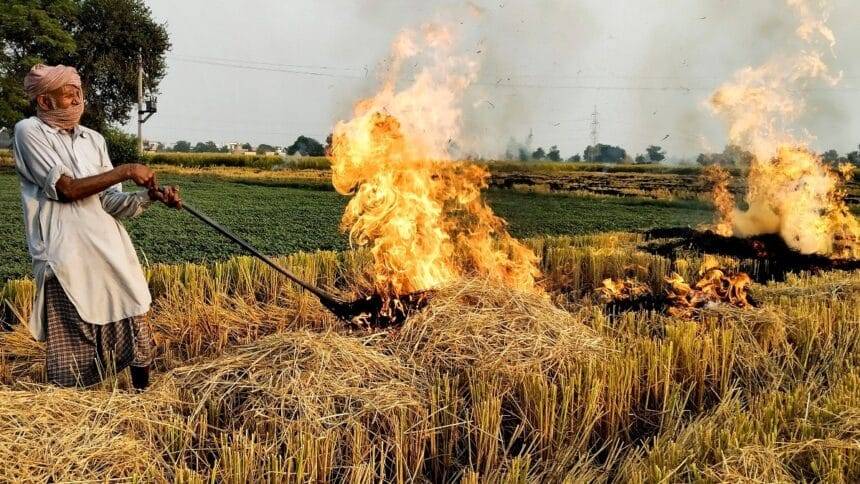Main Points In Hindi (मुख्य बातें – हिंदी में)
-
पराली जलाने और स्मॉग संकट: उत्तर भारत, विशेष रूप से पंजाब, पराली जलाने के कारण गंभीर स्मॉग संकट से जूझ रहा है, जिससे फसल अवशेषों के निपटान के लिए चल रही महत्वाकांक्षी परियोजनाएं प्रभावित हो रही हैं।
-
कंप्रेस्ड बायोगैस (सीबीजी) संयंत्रों की रुकावट: पंजाब सरकार ने 38 सीबीजी संयंत्रों की योजना बनाई थी, लेकिन केवल 5 संयंत्र ही संचालन में हैं, जो भी पूर्ण रूप से सक्रिय नहीं हैं। किसान विरोध प्रदर्शनों ने इन संयंत्रों के संचालन को रोक दिया है।
-
किसानों की चिंताएँ: किसानों का कहना है कि सीबीजी संयंत्र पर्यावरण को नुकसान पहुंचा रहे हैं और स्वास्थ्य के लिए खतरा उत्पन्न कर रहे हैं। विरोध प्रदर्शनों की वजह से चार संयंत्र बंद पड़े हैं, जिसके परिणामस्वरूप पराली जलाने की घटनाओं में वृद्धि हुई है।
-
आर्थिक प्रभाव: किसानों को पहले अधिक रेट पर पराली का भुगतान मिल रहा था, लेकिन आंदोलन के कारण यह दर घटकर 150-200 रुपये प्रति क्विंटल हो गई है। इससे किसान फिर से पराली जलाने के लिए मजबूर हो रहे हैं।
- वायु गुणवत्ता संकट: उपग्रह रिमोट सेंसिंग के अनुसार, पंजाब में अवशेष जलाने की घटनाओं में उल्लेखनीय वृद्धि देखी गई है, जिससे दिल्ली के वायु प्रदूषण में भी इजाफा हुआ है। 15 सितंबर से 2 नवंबर के बीच पंजाब में फसल अवशेष जलाने की 3,916 घटनाएं दर्ज की गईं हैं।
Main Points In English(मुख्य बातें – अंग्रेज़ी में)
Here are the main points of the article regarding the stubble burning crisis in Northern India and the compressed biogas (CBG) project aimed at addressing it:
-
Serious Smog Crisis: Northern India, particularly Punjab, is facing a severe smog crisis primarily due to stubble burning, leading to a halt in an ambitious project designed to manage agricultural waste.
-
CBG Plant Challenges: Although Punjab aimed to set up 38 CBG plants to convert agricultural waste into compressed natural gas, only five are operational, none at full capacity, largely due to ongoing farmer protests which claim these plants contribute to environmental harm.
-
Environmental and Health Concerns: Farmers argue that the CBG plants pose health risks to nearby communities by potentially contaminating air and soil, which has led to the closure of four operational units amid widespread protests.
-
Economic Impact of Protests: The protests have adversely affected the farmers financially, as payments for stubble have drastically decreased, and the closure of CBG plants has returned many to the option of burning excess agricultural waste.
- Increase in Burning Incidents: Recent satellite data shows an uptick in stubble burning events, with Punjab leading the statistics. Between September 15 and November 2, 9,376 such incidents were recorded in four key states, with Delhi’s air pollution significantly worsened as a result.


Complete News In Hindi(पूरी खबर – हिंदी में)
चूँकि उत्तर भारत पराली जलाने के कारण गंभीर स्मॉग संकट से जूझ रहा है, कृषि अपशिष्ट से निपटने की एक महत्वाकांक्षी परियोजना अब रुकी हुई है।
पराली जलाने की समस्या के स्थायी समाधान के रूप में प्रचारित कंप्रेस्ड बायोगैस (सीबीजी) संयंत्रों के साथ प्रदूषण से निपटने की पंजाब की पहल, किसानों के चल रहे विरोध प्रदर्शनों के कारण गंभीर रूप से बाधित हुई है। राज्य ने ऐसे 38 संयंत्रों को संचालित करने की योजना बनाई थी, फिर भी केवल पांच ही क्रियाशील हैं – कोई भी पूरी क्षमता पर नहीं।
संपीडित बायोगैस का वादा
फसल के ठूंठ, गाय के गोबर और प्रेस-कीचड़ जैसे कृषि अवशेषों को संपीड़ित प्राकृतिक गैस में परिवर्तित करने के लिए डिज़ाइन किए गए सीबीजी संयंत्रों की कल्पना दोहरे उद्देश्य वाले समाधान के रूप में की गई थी। इन सुविधाओं का उद्देश्य पराली को संभालने के लिए एक पर्यावरण अनुकूल तरीका प्रदान करना था, जो एक कृषि उपोत्पाद है, जिसे जलाने पर वायु प्रदूषण में भारी योगदान होता है।
किसानों को अपने फसल अवशेषों को जलाने के बजाय इन संयंत्रों को आपूर्ति करने के लिए प्रोत्साहित किया गया, इस उम्मीद के साथ कि इससे प्रदूषण कम होने के साथ-साथ बायोगैस और अन्य उपोत्पाद उत्पन्न होंगे।
वास्तविकता दृष्टि से टकराती है
हालाँकि, अपने वादे के बावजूद, इस परियोजना को प्रतिरोध का सामना करना पड़ा है। विरोध प्रदर्शनों ने चार सीबीजी संयंत्रों के संचालन को रोक दिया है, किसानों का तर्क है कि ये संयंत्र पर्यावरणीय नुकसान में योगदान करते हैं। किसानों ने यह भी दावा किया कि सुविधाएं आस-पास के समुदायों के लिए स्वास्थ्य जोखिम पैदा करती हैं, संभावित रूप से हवा और मिट्टी दोनों को प्रदूषित करती हैं।
इंडिया टुडे की टीम ने गुंगराली गांव (लुधियाना) में सीबीजी प्लांट का दौरा किया और पाया कि जो सुविधा 2022 में चालू हुई थी वह अब इस साल मई से बंद पड़ी है क्योंकि किसानों के विरोध प्रदर्शन ने इसे काम नहीं करने दिया।
“प्लांट की स्थापना पराली की समस्या से निपटने और पर्यावरण की मदद करने के उद्देश्य से की गई थी। आज पंजाब औद्योगिक क्षेत्र के लिए खतरा बनता जा रहा है। प्लांट की स्थापना पर कुल 70 करोड़ रुपये खर्च हुए। हालांकि प्लांट बंद है।” विरोध प्रदर्शन के बावजूद, हम अभी भी कर्मचारियों को भारी ईएमआई और वेतन दे रहे हैं,” प्लांट ऑपरेशनल हेड, पंकज सिंह ने कहा।
उन्होंने कहा, “इतना ही नहीं, क्षेत्र में तीन अन्य संयंत्र भी बंद हैं और हम दरवाजे खटखटा रहे हैं, लेकिन राज्य ने कुछ नहीं किया है।”
प्लांट की क्षमता के बारे में बात करते हुए पंकज सिंह ने कहा, “एक सीजन में हमें 35 हजार टन पराली मिलती है. एक दिन में 30 टन पराली से हम हर दिन आठ टन सीएनजी बनाते हैं.”
अपूर्ण क्षमता एवं आर्थिक प्रभाव
केंद्र द्वारा पंजाब ऊर्जा विकास एजेंसी (पीईडीए) को कुल 38 ऐसे संयंत्र आवंटित किए गए थे, लेकिन आज तक केवल पांच ही परिचालन शुरू कर सके। पंकज सिंह ने इस बात पर भी जोर दिया कि यदि सभी संयंत्र चालू होते, तो पराली जलाने की समस्या बहुत पहले ही हल हो गई होती।
पंजाब में किसान आंदोलन के कारण समराला, लुधियाना के भुंतरी, जगराओं के अखाड़ा में सीबीजी प्लांट बंद हो गए।
बलजीत सिंह, एक किसान, जिन्होंने शुरुआत में सीबीजी परियोजना में 2 करोड़ रुपये से अधिक का निवेश किया था और पहले पौधों को पराली उपलब्ध कराई थी, ने इंडिया टुडे टीवी को बताया कि सीबीजी संयंत्रों के उद्देश्य के बारे में गलतफहमियां जिम्मेदार हैं।
“मैंने पहले कनाडा जाने के बारे में सोचा था, लेकिन पर्यावरण के हित में मैंने यहां निवेश किया। हालांकि, हमारे किसान इन संयंत्रों के पूरे उद्देश्य को नहीं समझ पाए। हम इन संयंत्रों से जुड़े हुए थे और किसानों के आरोप निराधार हैं। आंदोलन के कारण, संयंत्र बंद हैं और परिणामस्वरूप, बड़े पैमाने पर पराली जलाई जा रही है,” उन्होंने कहा।
सिंह ने यह भी उल्लेख किया कि आंदोलन ने कई किसानों को पराली जलाने के लिए प्रेरित किया है, और पराली के लिए भुगतान – जो एक समय 1,650 रुपये प्रति क्विंटल था – अब घटकर लगभग 150-200 रुपये रह गया है।
खेत की आग और वायु गुणवत्ता संकट
भारतीय उष्णकटिबंधीय मौसम विज्ञान संस्थान (आईआईटीएम) के आंकड़ों के अनुसार, उपग्रह रिमोट सेंसिंग से छह भारतीय राज्यों में चावल की फसल से जुड़े अवशेष जलाने की घटनाओं में उल्लेखनीय वृद्धि का पता चला है। 2 नवंबर को उपग्रहों ने ऐसी 861 घटनाओं का पता लगाया 379 मामले दर्ज करते हुए पंजाब विशेष रूप से सबसे आगे है.
15 सितंबर से 2 नवंबर तक पंजाब, हरियाणा, राजस्थान और उत्तर प्रदेश में अवशेष जलाने की कुल 9,376 घटनाएं दर्ज की गईं।
पंजाब 3,916 घटनाओं के साथ आंकड़ों में सबसे आगे है, जो फसल कटाई के बाद के कचरे के प्रबंधन में उसके लंबे समय से चले आ रहे संघर्ष को उजागर करता है। 2,302 घटनाओं के साथ मध्य प्रदेश, 1,272 घटनाओं के साथ उत्तर प्रदेश, 1,036 घटनाओं के साथ राजस्थान और 838 घटनाओं के साथ हरियाणा दूसरे स्थान पर है।
दिल्ली के वायु प्रदूषण में अवशेष जलाने का योगदान पिछले दिन के 27.6 प्रतिशत से बढ़कर 1 नवंबर को 35.2 प्रतिशत हो गया, जो इस मौसम का उच्चतम स्तर है।
Complete News In English(पूरी खबर – अंग्रेज़ी में)
North India is facing a serious smog crisis due to stubble burning, and an ambitious project aimed at managing agricultural waste is currently stalled. Punjab’s initiative to combat pollution through compressed biogas (CBG) plants, promoted as a permanent solution to the stubble burning problem, has faced significant interruptions due to ongoing farmer protests. The state planned to operate 38 such plants, but only five are functional, and none are running at full capacity.
The Promise of Compressed Biogas
CBG plants were designed to convert agricultural residues like crop stubble, cow dung, and press mud into compressed natural gas. These facilities aimed to provide an eco-friendly method to manage stubble, an agricultural byproduct that contributes significantly to air pollution when burned. Farmers were encouraged to supply their crop residues to these plants instead of burning them, with the hope that this would reduce pollution and generate biogas and other byproducts.
Reality Hits Hard
However, despite the initial promise, the project has faced resistance. Protests have halted the operations of four CBG plants, with farmers arguing that these facilities contribute to environmental harm. They also claim that the plants pose health risks to nearby communities, potentially polluting air and soil.
The India Today team visited a CBG plant in Gungarali village (Ludhiana) and found that the facility, which started operations in 2022, has been shut down since May of this year due to protests. The plant’s operational head, Pankaj Singh, mentioned, “The plant was established to tackle the stubble problem and help the environment. Today, it threatens the industrial sector in Punjab. We spent a total of 70 crore rupees to set up the plant. Despite being closed, we continue to pay staff significant EMIs and salaries.”
Singh added, “Not only is our plant shut, but three other plants in the region are also closed, and we are knocking on doors for help, yet the state has done nothing.” Talking about the plant’s capacity, he mentioned, “In one season, we receive 35,000 tons of stubble. We can make eight tons of CNG per day from 30 tons of stubble.”
Underutilized Capacity and Economic Impact
The central government allocated a total of 38 such plants to the Punjab Energy Development Agency (PEDA), but only five are currently operational. Singh emphasized that if all the plants were running, the stubble burning issue would have been resolved much earlier. Due to the farmer protests, CBG plants in Summerala, Bhunthri of Ludhiana, and Akhada of Jagraon have been shut down.
Baljeet Singh, a farmer who initially invested over 2 crore rupees in the CBG project and supplied stubble to the plants, told India Today TV that misunderstandings about the purpose of CBG plants are to blame. “I initially considered going to Canada, but I invested here for environmental reasons. However, farmers have not grasped the full intent of these plants. We were associated with these facilities, and the farmers’ accusations are baseless. Due to the protests, the plants are closed, leading to increased stubble burning,” he said.
Sukhbir Singh also noted that the protests have pushed many farmers back into burning stubble, and the payment for stubble, which was once 1,650 rupees per quintal, has now dropped to about 150-200 rupees.
Field Fires and Air Quality Crisis
Data from the Indian Tropical Meteorology Institute (IITM) indicates a significant increase in incidents of burning crop residues across six Indian states. Satellites detected 861 such incidents on November 2, with Punjab being the most affected, recording 379 cases.
Between September 15 and November 2, a total of 9,376 incidents of residue burning were reported in Punjab, Haryana, Rajasthan, and Uttar Pradesh. Punjab led with 3,916 incidents, highlighting its long-standing struggle with managing post-harvest waste. Madhya Pradesh reported 2,302 incidents, Uttar Pradesh had 1,272, Rajasthan had 1,036, and Haryana had 838.
The contribution of residue burning to air pollution in Delhi rose from 27.6 percent to 35.2 percent on November 1, marking the highest level this season.








